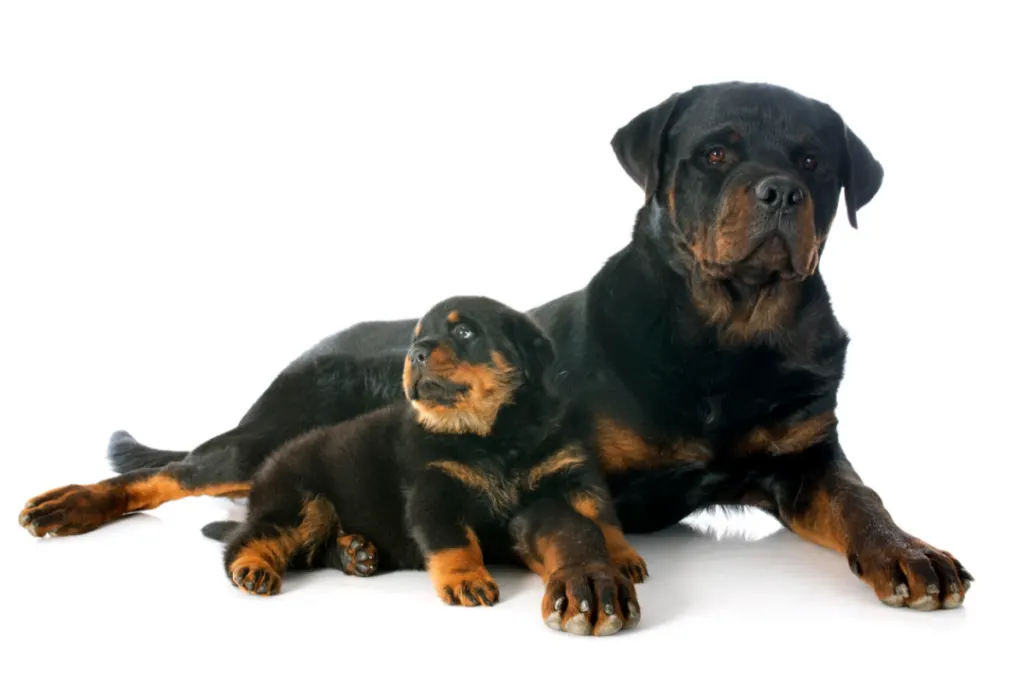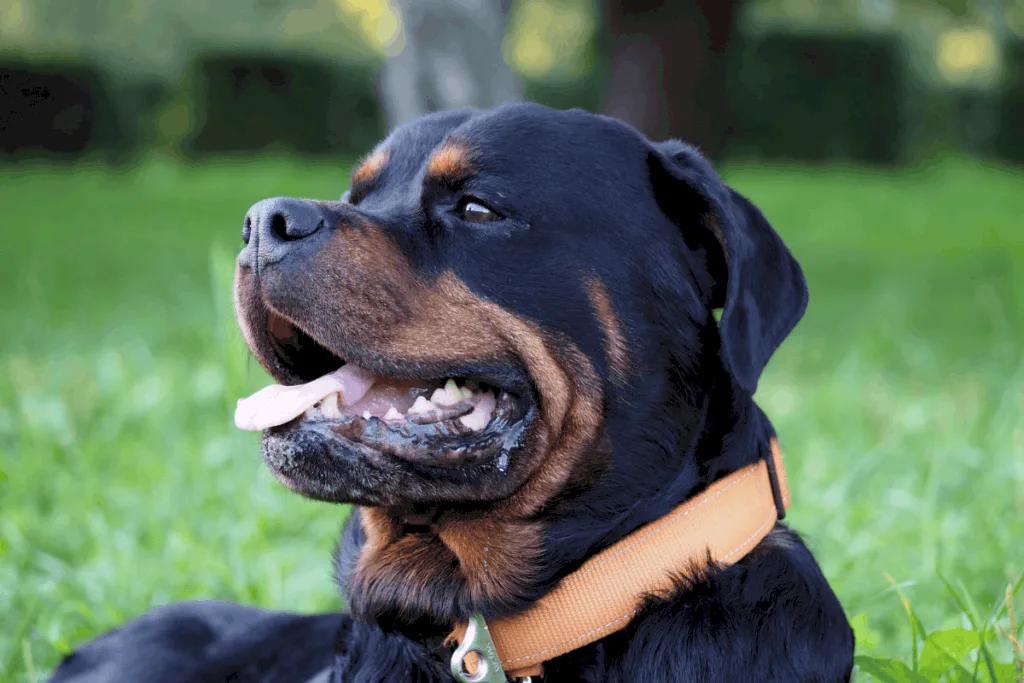The cutest little ball of snuggly Rottie pup will quickly turn into a hulking giant of an adult Rottweiler!
Do you know how big Rottweilers get, and are you prepared to take on this rather sizeable muscle-bound hunk of a dog?
Male Rottweilers grow to a height of 24″ to 27″ and a length of approximately 27″ to 30″ excluding the tail. Female Rottweilers reach a height of 22″ to 25″ and a length of approximately 24″ to 28″. Healthy adult Rottweilers weigh between 80lbs to 135lbs.
One of the most common reasons large dogs, like Rottweilers, are surrendered is because they grew too big and can’t be accommodated in smaller houses.
Forewarned is forearmed: Understanding how big a Rottweiler grows allows potential owners to make an informed choice!

What Do Breed Societies Say About A Rottweiler’s Size?
When specifying the ideal size of a Rottweiler, breed societies like the American Kennel Club (AKC) will measure the dog’s size according to four parameters:
- Height at the shoulder
- Length of the dog from the Rottweiler’s breastbone (mid-sternum) to the point of the buttocks (ischial tuberosity)
- General proportions and overall appearance
- Weight
Most breed societies around the world share an almost identical breed standard regarding Rottweiler size.
However, minor deviations are observed between countries due to the errors introduced by converting measurements between different measuring systems.
Rottweiler Height
Males – 24 inches to 27 inches
Females – 22 inches to 25 inches
The above-listed heights are the AKC accepted height; however, the ideal Rottweiler height exists in the median range of accepted heights.
The perfect height for males is between 25 inches to 26 inches. Males shorter than this are classified as small and larger males are classified as very large.
The ideal height for female is 23 inches to 24 inches, and females outside of this range are classified as small or very large.
(Source: AKC)
Rottweiler Length
The ideal Rottweiler length is expressed as a height: length ratio.
A Rottweiler’s length should never be more than 115% of its height, but the perfect ratio is closer to a 90:100 ratio for height to length.
The Rottweiler has a slightly rectangular shape to their bodies, this is part of what gives them their distinct stature.
They do not have the stretched out slinky-shape of Dachshund, but they are not built to fit into a square mold either!
General Proportions And Overall Appearance Of Rottweilers
Rottweilers should have thick bones, deep, broad chests, and good muscle coverage over their entire bodies.
Every part of the Rottweiler should convey an impression of sturdy practicality, unstoppable strength, and harnessed power.
A Rottweiler demonstrating fragility in any part of their conformation will be immediately eliminated from breed shows and removed from any breeding program.
Although the Rottweiler was bred as a dual-purpose dog, they never functioned as a hunter or coursing dog.
A Rottweiler who is built along the lines of a Greyhound, Afghan, or Saluki is NOT a Rottweiler!
(Source: AKC, The Kennel Club)
Rottweiler Weight
Weight is the only size parameter that will change throughout a Rottweiler’s life.
As such, the range of accepted weights is significantly larger than the ranges given for height, length, and body proportions.
Most healthy adult Rottweilers will weigh between 80 to 135 pounds.
Why Are Rottweilers So Big?

The Rottweiler and its ancestors have performed many roles over the centuries, in which their size was integral to their success.
The invading Roman’s Asian Mastiffs’ mated with the Germans’ drover dogs giving rise to the first “prototype” Rottweilers.
These dogs were famous for the ability to herd and staunchly defend “their” livestock charges from any possible threat of danger, human and animal included!
Gradually, butchers, herders, and other farmers found that the Rottweiler’s powerful build could be usefully harnessed to pull light loads to and from the market.
The advent of trains and cars saw a decline in the agricultural use of Rottweilers; however, their life as working dogs was not over yet.
Their fearsome appearance, trainability, and sheer strength made them invaluable to the police, military, and other defense organizations.
From there, the Rottweiler was promoted as a therapeutic guide to the blind.
The Rottweiler’s steady presence and large size meant they didn’t inadvertently trip up their visually impaired owners, unlike toy dog breeds!
Modern Rottweilers continue to defend their families faithfully and have been known to lay down their lives in service to their country!
Throughout the Rottweiler’s history, their size and strength have proven invaluable in their service to their owners.
(Source: AKC; VCA Hospital)
Nature Vs. Nurture And Rottweiler Size
The genetic characteristics of a Rottweiler will determine how big he CAN grow, but it does not guarantee he will fulfill that genetic promise.
How the Rottweiler is raised will have as much of an impact on his final size as his genetic heritage does.
Rottweiler puppies who receive inadequate nutrition or experience adverse conditions during puppyhood are unlikely to achieve their maximum potential size.
Management Issues Which Will Stunt A Rottweiler’s Growth
- Poor nutrition
- Excessive exercise with limited ability to sleep
- Anxiety and chronically heightened stress levels
- Worm infestations
- Chronic and acute illnesses, e.g., liver disease
- Early sterilization
(Sources: VCA Hospital; PetMD)
Genetic Issues Which Will Stunt A Rottweiler’s Growth
- Dwarfism
- Congenital hypothyroidism
- Lymphocytic thyroiditis
- Chronic progressive lung disease
- Congenital renal disease, e.g., polycystic kidneys
- Hemolytic anemia
- Hereditary spinal muscular atrophy
- Malnutrition caused by Protein-losing enteropathy
Many conditions can negatively affect your Rottweiler’s growth, some of these can be treated, and your Rottweiler will catch up any “lost” growth.
In comparison, other conditions are unalterable or were treated too late to undo the damage.
You can read more about these growth-stunting variables here.
(Source: Humane Society Veterinary Medical Association)
A Word On Disreputable Breeders
Backyard breeders supplying the pet market will often breed their dogs according to the latest fashions or fads instead of complying with breed regulations.
Rottweilers from these breeders may be smaller or larger than the standard Rottweiler.
The height deviation is not a severe health risk, although it often indicates the breeder’s priorities when breeding her dogs.
These Rottweilers often demonstrate poor health, temperament, conformation, and improper breed characteristics that directly impact their ability to function as healthy family dogs.
The Rottweiler is always the one who is forced to pay the price for human greed, as seen with breeders that breed carelessly for financial gain and then sell their puppies to unsuitable homes.
Final Thoughts
Owning any dog is a big commitment, but the power and strength of the Rottweiler put a new emphasis behind the word BIG.
Rottweilers are large dogs, not just in size but in temperament as well. It’s important to remember that your puppy will grow into the promise of those giant paws, and they’re an adult a lot longer than they’re a puppy!
Owners prepared to make that leap into Rottweiler ownership won’t be sorry.
The owner’s love and care are paid back in spades as their Rottweiler grows into a staunch ally and fierce defender of his family.
Between protective duties, Rottweilers frequently moonlight as therapy dogs and cuddly teddy bears!
